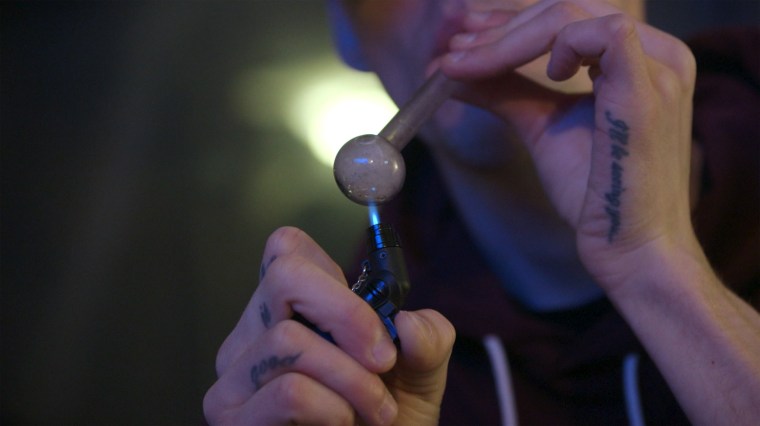A month after Terrence Crawford came out as gay in 2013, he met up for the first time with a man he met on a gay dating app. Unbeknownst to him, it would also be the first night he would use crystal methamphetamine, which quickly spiraled into a full-fledged addiction that would consume his life for the next two years.
“I felt comfortable in my skin for the first time, and comfortable having gay sex for the first time as a newly out young man,” Crawford said of his first experience using meth, a highly addictive stimulant. “It’s an experience I tried to replicate in all my subsequent uses.”
From 2011 to 2016, the number of drug overdoses involving methamphetamines more than tripled, according to the Centers for Disease Control and Prevention, and the 2015 National Survey on Drug Use and Health found gay men use meth at four times the rate of their heterosexual counterparts. Regular users of meth, in turn, increase their chances of contracting HIV by 400 percent, according to Rutgers University's Center for Health, Identity, Behavior and Prevention Studies.
After two years spent wrestling his addiction — and wanting to shed light on meth’s rise in usage and impact on the gay community — Crawford pitched a film idea about meth use and recovery among gay men in New York City to a room of his peers at New York University in 2015. That idea eventually became a documentary, “Crystal City,” which is having its New York premiere Sunday at NewFest, an annual LGBTQ film festival.
“I had a lot of embarrassment and shame and fear of the stigma associated with this topic,” Crawford told NBC News. “There aren’t a lot of positive templates for people in addiction seeking recovery. I wanted to change that by making a film showing that addicts can recover and live in sobriety.”
“Crystal City” follows the harrowing journey of current and former addicts in New York City, all of whom knew Crawford from his recovery process. For both Crawford and Rob Copeland, another recovering meth addict, the film was another step toward redemption.
“It happened at a point in my recovery where I had become aware of how important it was to let go of all the shame and fear that had built up in my life,” Copeland said. “After all, that was the source of my self-medicating.”
Gay men cope with "minority stress," such as social stigma and discrimination that make them more likely to use illicit substances, research has found.
“Meth can help people disassociate from their pain, their loneliness,” according to Dr. David Fawcett, one of the film's interview subjects and author of “Lust, Men and Meth.” "Meth is a really effective way to numb."
In the film, Fawcett discusses how the combination of stigma, shame, loneliness and substance abuse led crystal meth to become ubiquitous within the gay club and sex scene.
"Chemsex is this whole idea of using drugs as a way to enhance the sexual experience," Fawcett explains in the film. "I've had a lot of clients who've never been comfortable with gay sex who felt for the first time using methamphetamine they could celebrate being gay and having gay sex in a way they never experienced before."
"There are some estimates that one out of four gay men in major urban areas use meth regularly,' he adds. "It's at epidemic levels in the gay community."

For some men, including those featured in “Crystal City,” what began as a night out partying became kindling for the fire of their addiction. Like Crawford, Copeland met the man who introduced him to meth online — albeit over a decade earlier in 2000. Upon his arrival at the man’s place, Copeland said he was handed a glass pipe and told how to light it.
“I was willing to try anything, so I did. I didn’t know what it was, and I didn't even question what it was, he just said it would make me feel great,” Copeland said. “I fell in love with the drug immediately. It was euphoria.”
It didn’t take long for the drug to overpower him, he said, and within a year he was injecting meth intravenously. In rapid succession he lost his job, burned through his life’s savings and introduced his partner, Shane, to the addictive substance.
“There was a snowball effect. I couldn’t get enough, and I couldn’t get it fast enough. I spent more and more of my time looking for ways to use and means to use,” Copeland said. “Without consciously acknowledging it, I was preparing to die.”
When his supply ran out and he didn’t have enough money, he asked his dealer if he could take a small amount of meth to sell for profit. For the next five years Copeland survived by dealing meth to people across New York City — from wealthy businessmen to those living on the streets.
"Methamphetamine really impacts every sociological class, every person across the board," Fawcett notes during the intro of "Crystal City." "This is a tidal wave that we just can't close our eyes and ignore."
Copeland believes that if he hadn’t been arrested in 2012, he would be dead now. He pleaded guilty to conspiracy to distribute crystal meth, and only narrowly avoided being sent to prison due to a chronic health condition. Instead, he was put on probation for five years, two of which he spent in home detention with an ankle bracelet.
Last month, Copeland celebrated his fifth anniversary of sobriety. Both he and Crawford said the former addict community they found was integral to their recovery. The burden of shame that is often associated with meth addiction was gradually lifted from their shoulders.
“It’s not an exaggeration to say that stigma is killing people,” Fawcett said. “Connection is the key to recovery.”
Crawford hopes “Crystal City” can break down more barriers of stigma that surround meth addiction in the gay community by showing real stories of recovery, like Copeland’s.
“We all have our own journey,” Copeland said. “Sometimes it works, sometimes you stumble and fall, but you keep getting back up.”


